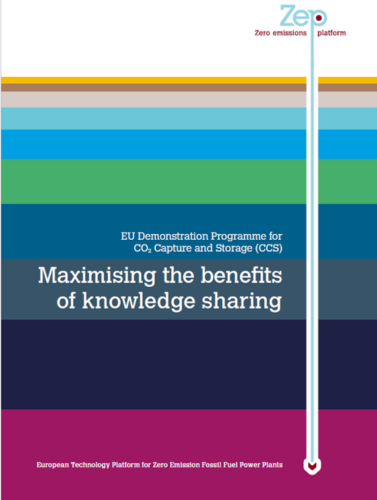Maximising the benefits of knowledge sharing
Introduction
The European Union (EU) has made significant progress in advancing CO2 Capture and Storage (CCS) as a critical technology for combating climate change. Indeed, EU CO2 reduction targets are not achievable without CCS. This was formally recognised by the European Council in March 2007. Just two years later, Europe has established a legal framework for the geological storage of CO2 and public funding to support an EU demonstration programme of 12 industrial-scale CCS projects. The goal: to accelerate technology development, drive down costs, build public confidence – and ensure CCS is commercially viable by 2020. Without such a programme, commercialisation will be severely delayed – until at least 2030 in Europe.
This reflects the recommendations of the European Technology Platform for Zero Emission Fossil Fuel Power Plants (ZEP) – a broad coalition of stakeholders united in their support for CCS and its leading authority in Europe. Members include European utilities, petroleum companies, equipment suppliers, national geological surveys, academic institutions and environmental NGOs.
Published in November 2008, ZEP’s Proposal for an EU Demonstration Programme for CCS included recommendations for knowledge sharing as key to accelerating deployment. In January 2009, the European Commission (EC) therefore asked ZEP to develop a more detailed proposal.
To this end, it has consulted experts both within the Platform and the wider CCS community, as well as Member State governments. The result is a proposal that, while not prescriptive, offers a clear and transparent framework for knowledge sharing that goes significantly beyond normal business practice. In fact, in the range and depth of knowledge recommended to be shared, it has no precedent.
Covering the full CCS value chain, it describes the main categories of knowledge, with specific recommendations on what should be shared3 – with whom and how – including practical solutions for disseminating knowledge as widely and rapidly as possible. It also includes suggestions as to how knowledge sharing may be practically set up and organised.
In short, ZEP’s proposal describes how knowledge sharing within an EU demonstration programme can help overcome the final barriers to the deployment of CCS – not only in Europe, but beyond.
Executive summary
Knowledge sharing is key to accelerating the deployment of CCS – in Europe and beyond
As a technology, CCS is now highly advanced, with the potential to reduce global CO2 emissions by 9 to 16 billion tonnes a year by 20504. But it means moving rapidly from small- to large-scale demonstration as the final step to commercialisation and deployment. The EU demonstration programme will not only enable us to integrate and optimise CCS technologies on an industrial scale, but “learn by doing”5 as the fastest way to accelerate technology development – de-risking CCS, driving down costs and ensuring commercialisation by 2020.
The availability of detailed results on performance and reliability will, in turn, give companies greater confidence to invest, while at the same time feeding into research programmes to develop next- generation technologies.
While ZEP’s proposal focuses on knowledge sharing within the EU, it therefore has profound consequences for the global deployment of CCS – both for developed and developing countries, with whom knowledge may be shared on a reciprocal or other basis.
But CCS cannot happen without the support of the public, among whom awareness is extremely low. By sharing a wide range of information, freely and openly, people will be able to make up their own minds on the benefits and issues surrounding CCS. This includes detailed findings on the long-term integrity of CO2 storage – of particular interest to communities living close to storage sites, but also to environmental NGOs, public authorities and national governments.
In terms of complexity, scope and commerciality, the EU CCS demonstration programme has no precedent
As CCS technologies are now at an advanced stage of development, the EU demonstration programme qualifies as pre-commercial – with the focus on deployment – where similar public-private partnerships have simply focused on Research & Development. In fact, knowledge sharing on such a scale – for a technology at this level of maturity
– has no direct precedent, either in Europe or worldwide. The legal basis for the EU CCS demonstration programme is Article 175(1) of the EC Treaty (Environment); while knowledge sharing is a legal requirement under Article 10a(8) of the revised Directive on the EU Emissions Trading Scheme (EU ETS), 2009/29/EC.
The pre-commercial status of the demonstration programme means that it must respect legislation designed to protect commercial rights and foster competition. Without such protection, companies may not risk putting forward their best technology, or be willing to join the programme. In order to ensure that the best CCS technologies are identified and brought forward for wide-scale deployment, ZEP’s proposal therefore focuses on knowledge sharing that is significantly beyond normal business practice – while maintaining the incentive to invest. It also follows a needs-based approach as not all stakeholders require all levels of knowledge.
Estimates of the size of the annual contribution by 2050 range from 0.6 GT in the EU and 9 GT worldwide (International Energy Agency (IEA) Blue Map scenario from their report, “CO2 Capture and Storage – a Key Carbon Abatement Option”), to 1.7 GT in the EU and 16 GT worldwide (The Bellona Foundation, “A Model for the CO2 Capture Potential”, by Dr Aage Stangeland, published in the International Journal of Greenhouse Gas Control, Volume 1, Issue 4, August 2007)
Stakeholders are divided into five groups:
- Contributors to the demonstration programme
- Non-contributors
- Research Institutes
- Government and the EU, and
- General Public and NGOs.
Knowledge is also divided into five categories covering the full CO2 capture, transport and storage value chain:
- Technical Set-up and Performance, including reliability; CO2 captured; performance; CO2 purity; incremental fuel demand; electricity, heat and cooling demand; key in-/outputs and design
- Cost Levels, including capital and operating costs; incremental costs per unit of performance
- Project Management, including lessons learned in legislation; stakeholder management; planning; and within the consortium/project group
- Environmental Impact, including the effectiveness of reducing CO2 emissions per unit of electricity and other environmental impacts of CCS in undisturbed operation
- Health and Safety, including significant incidents and near misses in disturbed operation; monitoring and resolution systems to track safety; health issues in undisturbed operation.
For each category, knowledge has been further divided into three levels of detail – Detailed, Medium and Aggregated – in order to provide full transparency, while ensuring stakeholders only receive the information they need.
Disseminating knowledge as widely and rapidly as possible
In order to facilitate the uptake of all CO2 Capture and Storage technologies demonstrated or developed within the demonstration programme, and which result from the EU-funded effort, all applicants6 should provide a Deployment Plan as part of the bidding process, specifying their strategies and planning to introduce CCS technology into the key markets of China, South Africa, India, Indonesia and Russia, and any other markets they expect to enter.
If a participant fails to comply with the plan, the Commission could then exercise Diffusion Rights under the grant agreement, in certain circumstances (see pages 17-18). These could include: contractual requirements for the grant of a set number of licences with full compensation at market rates to other companies within the EU. (NGO members of ZEP consider that contractual requirements for licensing may need to take place at below market rates in some circumstances, for example, in Less Developed Countries, where significant EU public funding is involved in funding a CCS project.)
A global CCS Patent Library should also be developed, covering all CCS patents and technologies utilised or developed during the demonstration programme. While registration should be compulsory for participants, it should be open to all CCS technology providers worldwide.
With regard to performance and process data, knowledge should be shared on the performance and interaction of technology building blocks, the performance of the plant overall and data resulting from actual operation of specific processes in a given set of operating conditions. Defining the precise level of data to be shared could then be established via a two-stage process:
- At the start of the selection process, applicants would commit to sharing data at the building block and major component level (subject to the test of practicality and protection of legitimate company interest in preventing reverse engineering of their technology)
- Once a short-list of projects has been made, they would then be asked to prepare a detailed schedule of knowledge sharing based on their project’s FEED study.
This includes all technology owners, host governments and their agencies involved in the demonstration programme, or with knowledge and Intellectual Property (IP) regarding overall process engineering and/or design, to be defined by a de minimis test
In addition, the following solutions are proposed:
- Regular joint workshops allow ‘live’ interaction between experts (for Contributors only)
- Technology owners may share more detailed engineering insights under a Non-Disclosure Agreement with non-competing parties (for Contributors and Research Institutes only)
- All contributors are required to complete a standardised report (available to all)
A wide range of communication channels should also be used, including a regularly updated website; Visitors’ Centre for each demonstration project; joint workshops; annual and milestone reports; and an observation seat for the EU on the supervisory board of the demonstration programme and/or each project. However, the proposal recommends only the minimum action required by participants – it is anticipated that most will supplement this with additional activities.
Knowledge sharing should be organised by an independent, centralised body
While the recording of data and findings will be carried out by participants, it should be assessed and coordinated by an organisation which is neutral, credible and independent. Such a body will not only provide maximum objectivity in the presentation of knowledge, but maximum alignment on theinterpretation of guidelines and external positioning. A centralised organisation can also synthesise knowledge across projects, and ensure quality and consistency. Supervised by a board of stakeholders, its costs should be met by public funding to ensure its independence.
1. Why knowledge sharing is key to accelerating the deployment of CCS
As a technology, CCS is now highly advanced, with the potential to reduce global CO2 emissions on a massive scale – between 9 and 16 billion tonnes a year by 2050.
This includes not only the power sector, but a wide range of other CO2-intensive industries as well. But it means moving rapidly from small- to large-scale demonstration as the final step to commercialisation and deployment. Any delay could not only lead to unnecessary CO2 emissions but additional costs, as instead of being able to apply it to the current pipeline of coal plants, a retrofit would be required, increasing the cost of achieving the same emissions reduction.
In Europe alone, it is estimated it will cost 40%8 more to achieve CO2 reduction targets without CCS.
De-risk CCS and enable commercialisation by 2020
Experts within ZEP and the wider CCS community have already identified the functional, operational and technical specifications for the technologies that require integration and optimisation across the CCS value chain – known as “Technology Blocks”.9
The EU demonstration programme will not only enable us to achieve this on an industrial scale, but “learn by doing” as the fastest way to accelerate technology development – de-risking CCS, driving down costs and ensuring commercialisation by 2020. The availability of detailed results on performance and reliability will, in turn, give companies greater confidence to invest, while at the same time feeding into research programmes to develop next-generation technologies.
The inclusion of a broad range of suppliers and technologies will ensure fair competition, but even those not participating in the programme will have access to a high degree of knowledge – significantly beyond the minimum legal requirement, e.g. to obtain permits. This can be shared by the programme as a whole, or by groups of companies running an individual project.
Accelerate the deployment of CCS worldwide
Climate change is a global problem and since a large proportion of CO2 emissions in the future will come from developing countries, it is essential that they, too, implement CCS as rapidly as possible. While ZEP’s proposal focuses on knowledge sharing within the EU, it therefore also includes both non-EEA10 and developing countries, with whom knowledge may be shared on a reciprocal or other basis. This will not only help accelerate the global deployment of CCS, but boost European industry and promote technology leadership.
Increase understanding and confidence in CCS
CO2 capture is already practised on a small scale, while the technology for permanent CO2 storage is almost identical to that used by the oil and gas industry for decades – to store natural gas or for enhanced oil recovery (EOR). In fact, it uses the same natural trapping mechanisms which have already
kept huge volumes of oil, gas and CO2 underground for millions of years. CO2 transportation is also well understood: it has been transported by ship regionally for over 17 years, while a 5,000 km onshore pipeline network for EOR has been operating in the US for over 30 years.
Nevertheless, although small-scale CO2 storage has been taking place successfully for over 12 years, awareness is extremely low. By undertaking large- scale projects in a variety of geographical and geological settings, we will not only gain experience from a full range of storage options, but build public confidence, as it is seen that the technology is both safe and reliable.
In this demonstration and consolidation phase, knowledge sharing will enable any remaining capability gaps to be closed and storage procedures optimised – establishing workflows, best practices and industry standards for a full range of storage options. This includes identifying, selecting and characterising a storage site; modelling the storage reservoir and assessing storage capacity; investigating CO2 thermodynamics; proving CO2 trapping mechanisms; and enhancing tools for monitoring CO2 and tracking its movement in the reservoir.
Knowledge sharing on CO2 storage will therefore play a vital role in ensuring that the first wave of demonstration projects on depleted oil and gas fields and, in particular, deep saline aquifers inform future permitting decisions on storage. All storage activities should be fully transparent and all storage technologies monitored in accordance with the EC Directive on Geological Storage of CO2.
This aspect of the demonstration programme’s knowledge sharing should be supervised by an independent, non-commercial organisation and include the 30-year period following transfer of responsibility, as referenced in the Directive.
Such verification could lead to more flexible regulation, but may require the organisation to share proprietary data. In such cases, ensuring confidentiality against fraudulent access would be mandatory and require a Non-Disclosure Agreement to be signed between the organisation and the technology owner.
By sharing a wide range of information, freely and openly, people can then make up their own minds on the benefits and issues surrounding CCS. This includes detailed findings on the long-term integrity of CO2 storage – of particular interest to communities living close to storage sites, but also to environmental NGOs, public authorities and national governments.
2. Maximising sharing… without compromising competition
As CCS technologies are now at an advanced stage of development, the EU demonstration programme qualifies as pre-commercial – with a focus on deployment – where other public-private partnerships have simply focused on Research & Development (R&D).
In fact, knowledge sharing on such a scale – for a technology at this level of maturity – has no direct precedent, either in Europe or worldwide. Nevertheless, the demonstration projects are “first of their kind and incur costs for the learning experiences they are designed to deliver”11 at a time when commercial demand does not yet exist – hence the need for public funding.
Certainly, no public-private partnership has shared knowledge on such a comprehensive range of topics – and to such a high level of detail – with such a broad range of stakeholders, as recommended in this proposal. Many such initiatives are also self-organising, with quality checks carried out by the participants themselves, as opposed to an independent body recommended by ZEP.
Nevertheless, the proposal has been cross-checked with a number of comparable programmes12 to ensure all stakeholders, topics and levels of sharing have been covered – and more – together with effective and proven methodologies. There is also a strong legal precedent for knowledge sharing that balances the need to maintain competition with the public interest, e.g. REACH chemicals legislation.
The legal basis for the establishment of the EU CCS demonstration programme is Article 175(1) of the EC Treaty (Environment), while knowledge sharing is a legal requirement under Article 10a(8) of the revised Directive on the EU Emissions Trading Scheme (EU ETS), 2009/29/EC.
Respect commercial rights and foster innovation
The pre-commercial status of the demonstration programme means that it must respect legislation designed to protect commercial rights and foster innovation. Indeed, this is essential to encourage investment and ensure the continued disclosure of technological breakthroughs through the patent system.
This, in turn, further enhances innovation by encouraging the development of alternative solutions to those protected by others. Without such protection, there is a risk that companies who have invested heavily in CCS – and already acquired commercially exploitable knowledge – may not risk putting forward their best technology, or be willing to join the programme.
Share significantly beyond normal business practice
It is vital that the best CCS technologies are identified and brought forward for wide-scale deployment. It is equally important that knowledge is disseminated as quickly and widely as possible – within both developed and developing countries. ZEP also recognises that the value of existing knowledge will increase as a result of the demonstration programme, as it moves closer to commercialisation.
The proposal therefore focuses on knowledge sharing that is significantly above the minimum legal requirement under existing legislation and beyond normal business practice. It also includes practical solutions for sharing IP and know-how (see pages 17-19). Some knowledge, of course, it is simply not feasible to share, e.g. tacit knowledge; or its generation may be prohibitively expensive, e.g. very frequent 4D seismic monitoring.
Establish a common methodology
As the EU demonstration programme will include a wide range of CO2 capture, transport and storage technologies, it is important that knowledge is evaluated via a common methodology. A precise definition of the parameters to be shared – including standardised formats – should be determined by a centralised body (see page 20), but existing industry standards provide a good basis.
However, the value of many parameters will depend on the characteristics of each individual project which, despite a common methodology, cannot be made comparable. Participants should therefore provide a general project description for each step in the CCS value chain, including characteristics which impact comparability, so that knowledge can be placed in context (Exhibit 1).
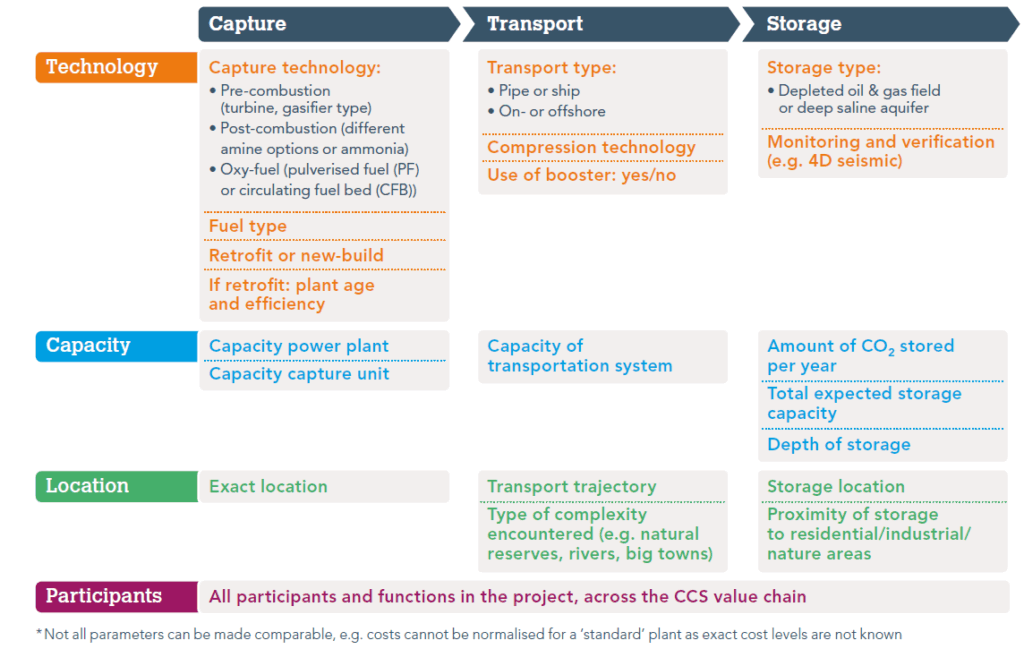
3. Meeting the needs of stakeholders
In order to ensure that all knowledge required by stakeholders is shared, ZEP’s proposal follows a needs-based approach as not all stakeholders require all levels of knowledge.
Identify groups of stakeholders
Stakeholders have been divided into five groups:
- Contributors to the demonstration programme;
- Non-contributors
- Research Institutes
- Government and the EU
- and General Public/NGOs.
Exhibit 2: There are five groups of stakeholders with whom knowledge should be shared
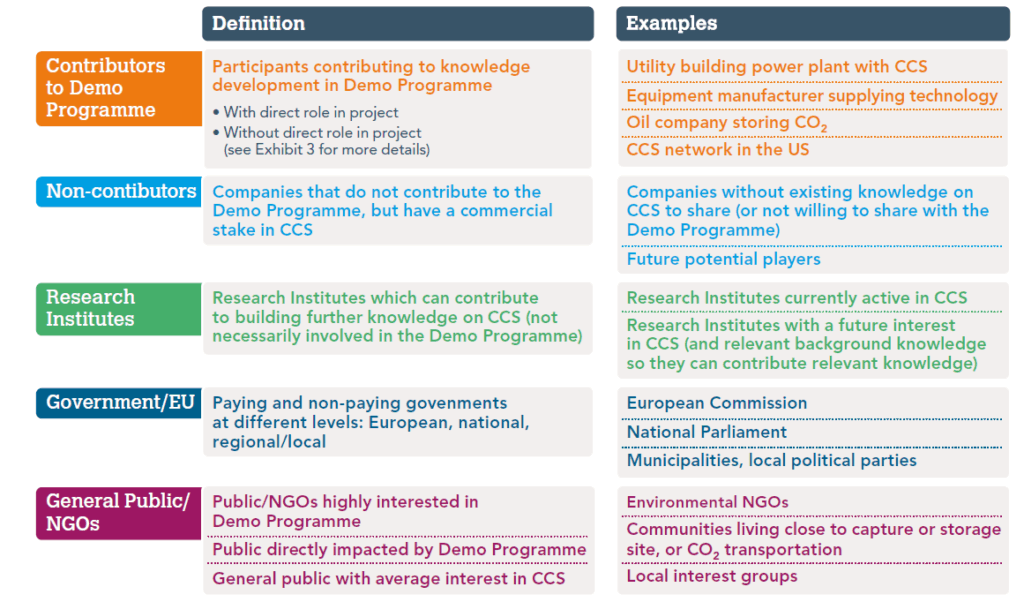
The key difference between Contributors and Non-contributors lies in the way in which knowledge is shared – where Contributors have access to interactive expert peer group workshops and detailed engineering insights (see page 18), Non-contributors only have access to a standardised report.
Contributors to the demonstration programme are further defined in Exhibit 3. It is essential that they include non-participants from both developed and developing countries in order to accelerate the global deployment of CCS. To be eligible, they must have comparable CCS projects or demonstration programme and be able to share knowledge on a reciprocal basis with the EU and developed countries; or on an asymmetric basis with developing countries, provided they recognise Intellectual Property Rights (IPR) or similar standards to those of the EU.
Exhibit 3: Contributors to the EU CCS demonstration programme may include non-participants from both developed and developing countries who have comparable CCS projects or demonstration programme
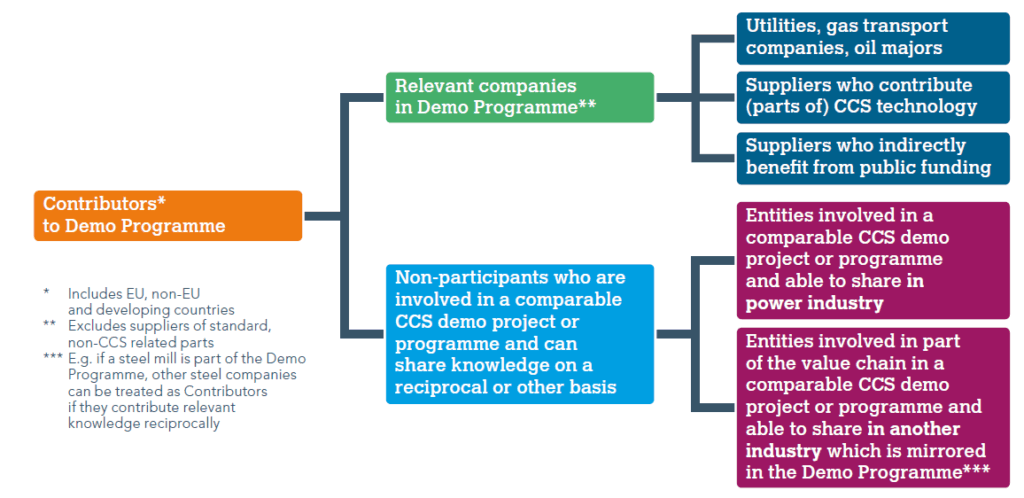
Identify categories of knowledge
Knowledge can be divided into five categories, covering the full CO2 capture, transport and storage chain – Technical Set-up and Performance, Cost Levels, Project Management, Environmental Impact, and Health and Safety (Exhibit 4).
Exhibit 4: Knowledge sharing within the EU CCS demonstration programme should cover a comprehensive range of issues for the five main knowledge categories


For each category, knowledge has then been further divided into three levels of detail: Detailed, Medium and Aggregated (Exhibits 5–9) in order to provide full transparency, while ensuring stakeholders receive only the information they need.
Exhibit 5: Detailed, Medium and Aggregated levels of knowledge sharing for Technical Set-up and Performance
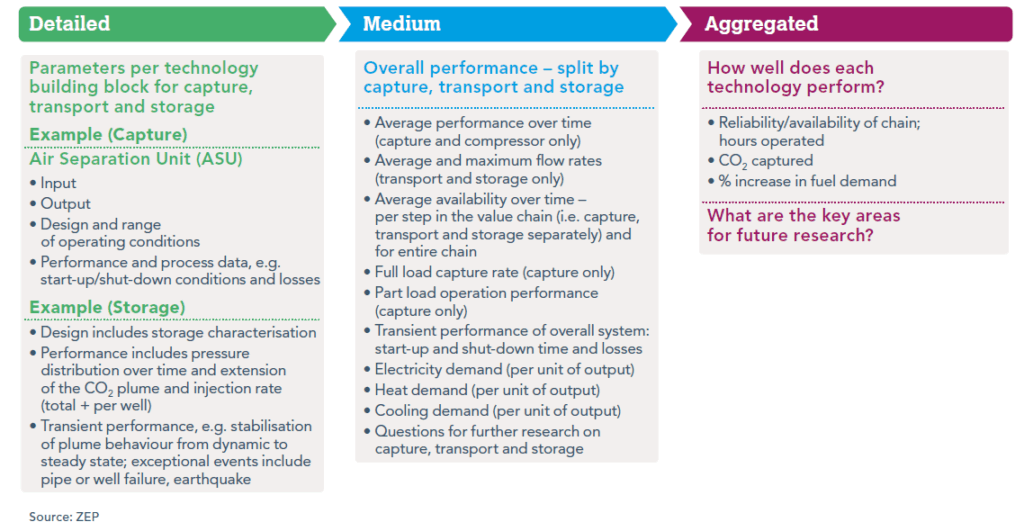
In the Detailed level, the design and range of operating conditions are governed by IPR; while the aim is maximum knowledge sharing, performance and process data should not be shared which would allow reverse engineering of the know- how, technology, products or processes involved in any of the CO2 capture or storage facilities. Knowledge should be shared on the performance and interaction of technology building blocks, the performance of the plant overall and data resulting from actual operation of specific processes in a given set of operating conditions.
Exhibit 6: Detailed, Medium and Aggregated levels of knowledge sharing for Cost Levels
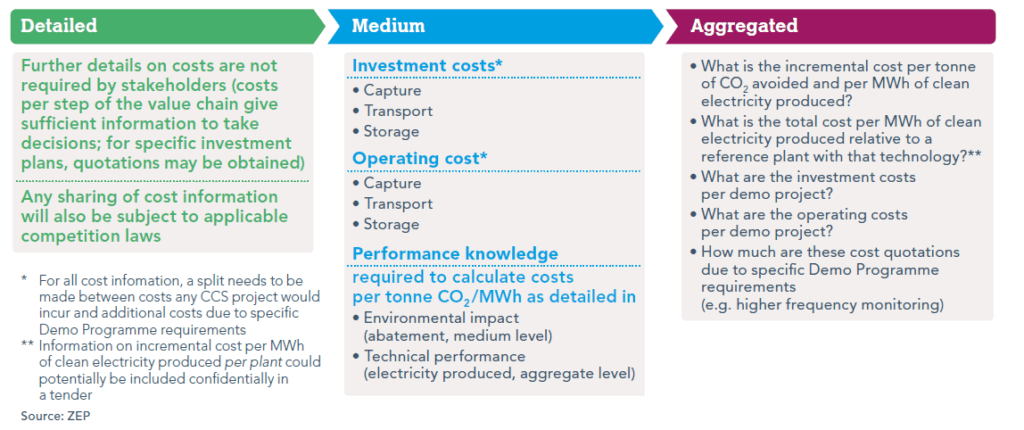
Sharing Detailed Cost Levels is not necessary, as costs per step of the CCS value chain provide sufficient information to take investment decisions while for specific investment plans, quotations may be obtained. Any sharing of cost information will also be subject to applicable competition laws.
Exhibit 7: Detailed and Aggregated levels of knowledge sharing for Project Management
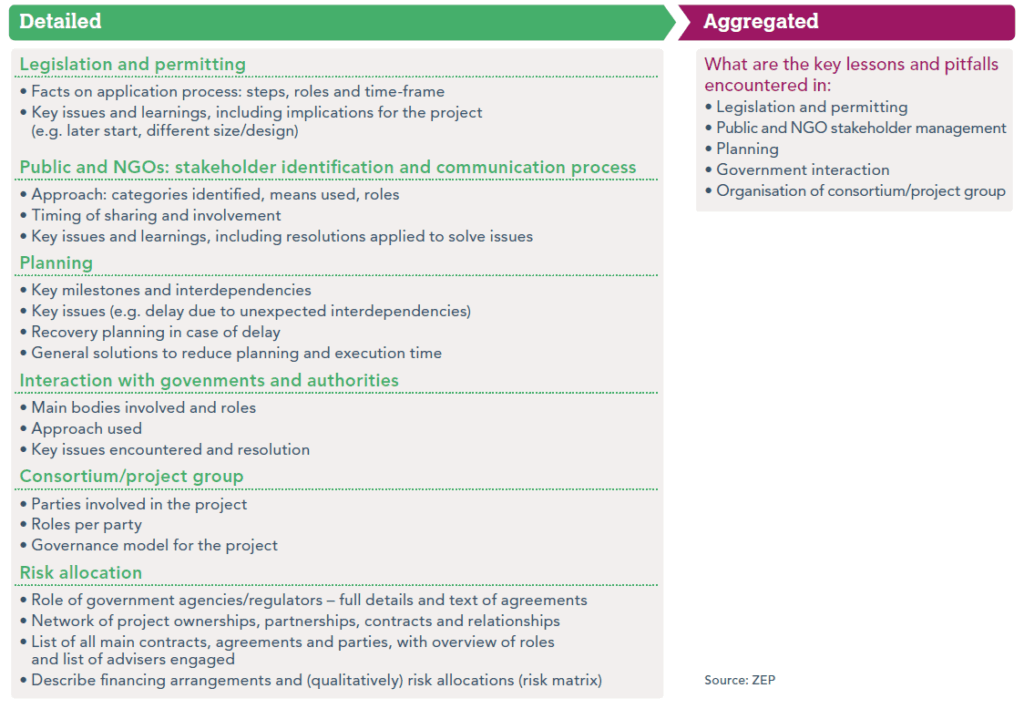
All knowledge may be shared, but the Medium level is not applicable.
Exhibit 8: Detailed, Medium and Aggregated levels of knowledge sharing for Environmental Impact
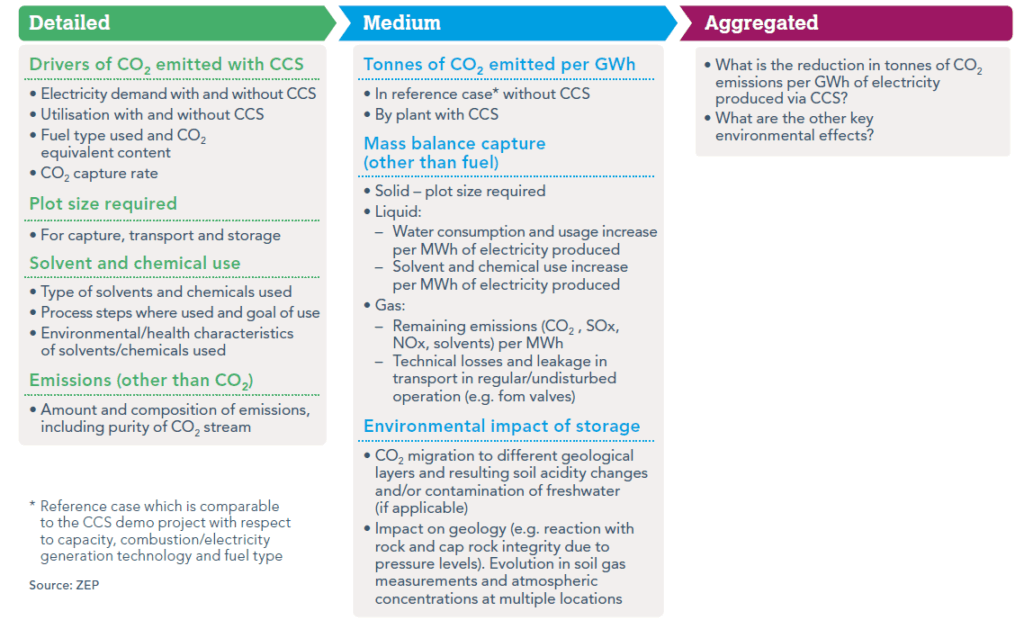
Detailed and Medium levels of knowledge sharing for Environmental Impact are significantly higher than the minimum legal requirement, e.g. to obtain permits.
Exhibit 9: Detailed, Medium and Aggregated levels of knowledge sharing for Health and Safety
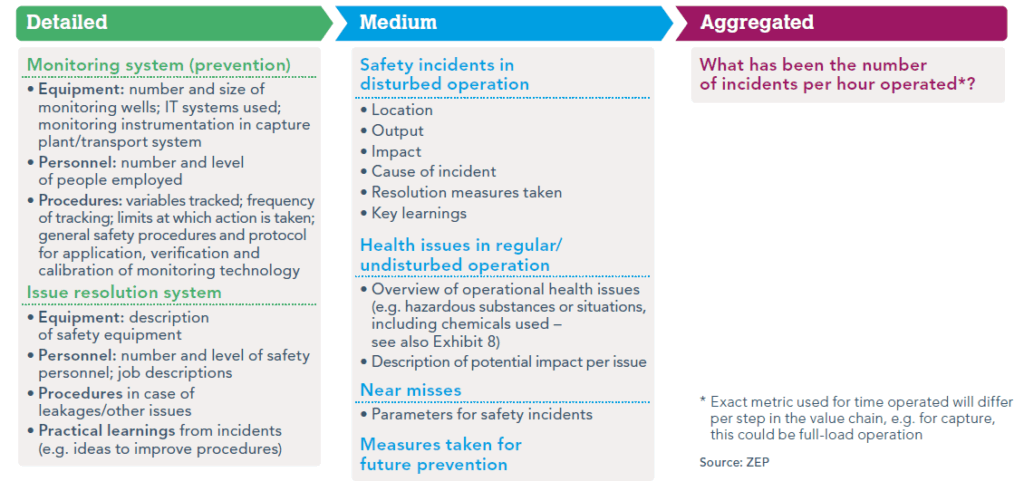
Detailed and Medium levels of knowledge sharing for Health and Safety are significantly higher than the minimum legal requirement.
Match stakeholder needs with the ability to share
An analysis of stakeholder needs shows that all desired knowledge can be shared, except for some Detailed information on Technical Set-up and Performance (Exhibit 10) which is either governed by IP Rights or subject to competitive constraints.
Exhibit 10: An analysis of stakeholder needs shows that all desired knowledge can be shared, except for some detailed information on Technical Set-up and Performance which is either subject to IP Rights or competitive constraints

4. Disseminating knowledge as widely and rapidly as possible
As the EU demonstration programme is designed to accelerate the deployment of CCS, this specifically includes identifying the best technologies to go forward.
However, some Detailed knowledge on Technical Set-up and Performance is subject to IP Rights or competitive constraints:
- Intellectual Property (IP): knowledge developed during the demonstration programme is strongly rooted in existing IP and therefore protected by IP Rights and the patent system. This means that although the knowledge is transparent, IP owners can decide whether to provide access to the application via licence, and on what terms, in order to protect competitive edge (applies to design and range of operating conditions)
- Know-how: knowledge which has competitive value, but which is not IP protectable. As it cannot be protected by patent, and no fee for sharing can be charged, sharing may hamper competition (applies to performance and process data).
Ensure the speedy diffusion of IP worldwide
- Commit to a Deployment Plan
All applicants (see footnote 6) should provide a Deployment Plan for the CCS technologies they intend to develop in the EU demonstration programme. This should become part of the project bidding process and the initial grant agreement between the participants and the EC, and be enforceable. It should be handled confidentially between the project and the Commission.
Deployment Plans should specify companies’ strategies and planning (or lack of intention) to introduce CCS technology into the key markets of China, South Africa, India, Indonesia and Russia, and any other markets they expect to enter. Plans should set an expectation that a commercial offer (market entry or licence availability) would be available in a reasonable period after that commercial offer is introduced into OECD13 markets, pending the evolution of the demonstration programme, the technology and the markets.
For countries where there are no plans for market entry, terms should be proposed for full commercial licensing and for segmented market agreements which limit exports back to OECD (and potentially other) markets. There should be an ongoing dialogue between the EU and the demonstration project developers about the shaping and development of key markets and the results of this should be factored into the evolution of the Deployment Plan.
Diffusion Rights (analogous to US March-in Rights) should be specified in the grant agreement to ensure that licensing of all CO2 Capture and Storage technologies demonstrated or developed within the demonstration programme, and which result from the EU-funded effort, is facilitated in certain circumstances.14 Such circumstances include failure to comply with the Deployment Plan within a specified reasonable period, without reasonable justification, or other failure to deploy and commercialise a technology.
The Diffusion Rights can only be exercised in certain circumstances and in accordance with a process to be specified in advance:
- The company concerned should first be given a reasonable period in which to execute its Deployment Plan. It would have to be clear that the company had either not complied with its plan (or not developed one).
- The EC would act only upon a request by a country or a third party to license the relevant technology held by a participant in the EU demonstration programme. The licence granted will only be valid for the country of the requested party.
- The requesting entity would need to demonstrate need for the technology/licence, appropriate conditions for its deployment and evidence from that third country or party that the participant was unreasonably refusing to license the technology.
(NGO members of ZEP consider that the rationale for public funding of the EU demonstration programme requires that Diffusion Rights are applied to all CO2 Capture and Storage technologies which are part of the demonstration programme in order that the rights apply to a fully viable technology which can be deployed in a developing country.)
Diffusion Rights could include: contractual requirements for the grant of a set number of licences with full compensation at market rates awarded to other companies within the EU. (NGO members of ZEP consider that given the significant public funding being provided to the demonstration programme, in some circumstances it would be appropriate to provide licences at below market rates in Less Developed Countries. Below market rates would be appropriate where re-export of the technology to the OECD is restricted and where significant European public financing is involved in constructing a CCS project in a Less Developed Country.)
The Commission should commit to assessing the adequacy of IPR protection and enforcement in the third country jurisdiction and, if necessary, propose and implement means by which the EU could actively try to secure IPR enforcement in the third country through, inter alia, bilateral government agreements, capacity building and/or assistance to EU SMEs.15
The licensee would also need to have committed to and demonstrated a track record of responsibility for respecting IP.
- Build a global CCS Patent Library
An open CCS Patent Library should also be developed, covering both CCS equipment used in the demonstration projects and any subsequent patents covering innovation developed as a result of the demonstration programme. Companies should also register the licensing terms (if any) under which they would be prepared to share the technology.
Patent registration would also be compulsory for any Research Institute involved in knowledge sharing within the demonstration programme, but optional registration should be open to all CCS technology providers worldwide.
Share know-how while maintaining the incentive to invest
There are several possible solutions for sharing know-how, for example:
- Regular joint workshops/site visits etc may be held over the course of the programme to allow ‘live’ interaction between experts (for Contributors only)
- Technology owners may share more detailed engineering insights under a Non-Disclosure Agreement with non-competing parties, allowing companies to improve their own technology without duplicating the know-how (for Contributors only)
- Research Institutes16 – both EU and non-EU – may also request access to any detailed technical set- up and performance knowledge via the centralised body. If the request is not overly burdensome or trivial, and the Research Institute can demonstrate that it can be trusted and add to the knowledge provided, it may be shared under a Non-Disclosure Agreement (NDA) between the Research Institute and relevant participants.
If a Research Institute is contributing directly to a demonstration project, it will likely form part of the consortium or be bound by the equivalent of a Consortium Agreement, in which case access to knowledge would be shared on an equal basis to that of the other members.
The credibility of the Research Institute should be determined by a standard of substantive CCS research capability, non-profit purpose and commitment to placing all results in the public domain (subject to the NDA). The centralised body (or the Commission) could help in the screening of applicants and facilitate agreements, but the final decision lies with the technology owner. - All Contributors are required to complete a standardised report (available to all).
Defining the precise level of data to be shared could be established via a two-stage process:
Stage 1: (‘ex ante’), applicants would commit to sharing performance and process data at the technology block and major component level, subject to the test of practicality and the protection of legitimate company interest in order to prevent the reverse engineering of their technology. Process data to be shared includes start-up and shut-down performance data, data on performance at different loads/pressure and data on the optimised steady state. This should be presented in a standard format by all projects.
Stage 2: Following the selection of a short-list of projects, applicants would then prepare a detailed schedule of performance data sharing (data, format, frequency of reporting) based on their project’s FEED study process, thus minimising the additional analytical costs and time involved. The Commission would then be able to evaluate the adequacy of the proposal and request additional data and detail, as required. This should form part of the standard process of bid refinement for each project.
Employ a wide range of communication channels
Reaching a wide range of stakeholders requires an equally wide range of communication channels. However, the recommendations below represent the minimum action required by participants. As a key objective is to make knowledge accessible to as many stakeholders as possible, it is anticipated that most companies will supplement this with additional activities.
Website
The EU demonstration programme should create and run a regularly updated website, including information, reports and press releases etc. This should have a multi-layered presentation, so that people can access the most basic or detailed explanation, according to need. It also provides the opportunity to answer any possible questions/ concerns – whether the reader is a journalist, NGO, policymaker or member of the public.
Visitors’ Centre
Every project should host a Visitors’ Centre, covering the full CCS value chain. This will provide continuous access to information on the demonstration project, with particular emphasis on monitoring/ safety information etc.
Observation seat
An observation seat for the EU should be created on the supervisory board of the demonstration programme and/or each project, giving access to the same level of information as is shared with government.
Workshops
Joint workshops/expert meetings involving Contributors should take place regularly, including focused expert meetings in sub-groups.
Reports
An annual report should be provided on progress and learnings on all knowledge categories for each demonstration project, with immediate reporting on all major events, including milestones (particularly during the building phase).
5. Running an efficient and transparent operation
While the recording of data and findings will be carried out by participants, it is important that this be assessed and coordinated by an organisation which is neutral, credible and fully independent.
Employ a neutral and independent body
Such a body will provide maximum objectivity and credibility in the presentation of knowledge to all stake- holder groups. It will also ensure maximum alignment, not only on the interpretation of definitions and guidelines, but external positioning for the programme as a whole towards, for example, the press. Criteria to be satisfied by this organisation therefore include:
- in-depth knowledge of CCS
- ability to process and compare large volumes of data
- independence of industry and politics
- supra-national status
- credibility in the eyes of government and the public.
Create alignment through centralisation
A centralised organisation will also be able to synthesise knowledge across projects, capture joint learnings and build expertise. Its responsibilities should include:
- Organising the process:
- Execute administrative tasks, e.g. distribute reports
- Organise meetings/workshops, in-house visits etc.
- Be the primary entry point for requests for data, questions, press contacts etc.
- Ensuring quality and consistency
- Make communicable products (e.g. reports), building on the standardised input
- Develop and propose joint definitions and methodological guidelines
- Check whether information is consistent with the methodological guidelines (and as agreed with the grant giver) and liaise with the data provider in case of non-consistency.
Supervised by a board of stakeholders, its costs should be met by public funding to ensure its independence.
Ensure compliance with knowledge sharing agreements
It is equally important to ensure all relevant parties are bound to knowledge sharing, regardless of the precise financing arrangements. This could be ensured by drafting an attachment to the contract that suppliers sign with utilities or project owners which binds the signatory to knowledge sharing agreements.
This could apply to all suppliers who contribute to CCS technology, or those who indirectly benefit from public funding through the increased development of their product. It therefore excludes suppliers of standard, non-CCS-related parts. If the knowledge sharing agreements are violated, varying degrees of action should then be taken, escalating through the chain of contracts to the utility or grant giver:
- Negative publicity on non-compliance as a first warning
- loss of (part of) future funding or the risk of the execution of claw-back options (depending on the funding structure)
- prosecution by the funder based on contractual rights.
October 2009
